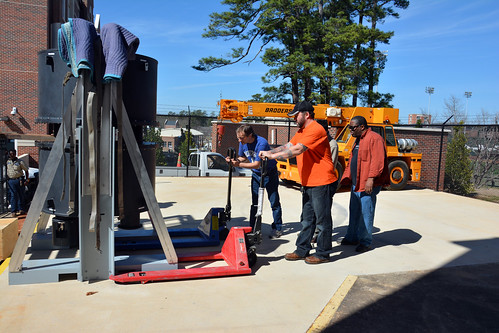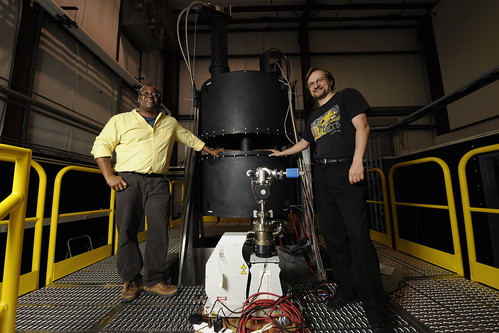COSAM News Articles 2014 May Auburn University opens unique, world-class plasma physics research laboratory
Auburn University opens unique, world-class plasma physics research laboratory
During the past five years, physics Professor Edward Thomas developed the mantra, "No stress, no stress, no stress." By repeating the phrase over and over, he had hoped to stave off any ill effects that might result from overseeing the creation of the new Magnet Laboratory at Auburn University, which included the development and delivery of a 6,000-pound superconducting magnet, the only one of its kind in the world.
The new lab houses the Magnetized Dusty Plasma Experiment, a one-of-a-kind facility that will support plasma physics research for Auburn University students and researchers, as well as for a diverse team of national and international researchers who will come to Auburn to perform experimental and theoretical studies. More than a dozen Auburn students, including undergraduates, graduates and postdoctoral-researchers, were involved in the design and implementation of the new laboratory, and as the research evolves over the next several years, Thomas envisions opportunities for a long line of undergraduate and graduate student researchers.
"The superconducting magnet in the laboratory is a one-of-a-kind device," said Thomas, the Lawrence C. Wit Professor of Physics in Auburn's College of Sciences and Mathematics. "There have been a half-a-dozen or so experiments around the world that have tried to explore the physics of magnetized dusty plasmas. We think of our device as the first, second-generation device, where we have taken a lot of the lessons we have learned on earlier devices and incorporated them into the design of this facility and tried to put together something that is pretty unique. The uniqueness stems from the fact that we can do something that no other device can do, which is shape the structure of the magnetic field."
The magnet arrived in late February, and the excitement felt by Thomas and his fellow researchers was palatable as they stood on a loading dock, watching the back of a delivery truck and anxiously waiting for the first glimpses of the 6,000-pound superconducting monster. The installation process was painstakingly tedious as the team worked to ensure not a scratch would harm the magnet even as a small crane lowered the beast into a pre-constructed platform in the lab.
Once installed, the magnet was connected to a series of pumps and tubes that carry compressed, gaseous helium to the coils inside the magnet. The compressed helium serves to cool the magnetic coils to extremely low temperatures.
"We had to get the coils cold before using the magnet. They went from room temperature to below 5.5 degrees Kelvin, or negative 450 degrees Fahrenheit. That's about a 520-degree drop, and it took about two weeks to bring the temperature down," said Thomas. "The whole process has been nerve-racking. Once the magnet was installed, you would think we would breathe a sigh of relief, but we were still holding our breath as we watched the temperature drop. We charted the temperature every four hours or so. The critical temperature point is 6.4 Kelvin. Once we get there, the magnet fields become superconductors. We breathed a big sigh of relief once the temperature was right, and at that point, we energized the thing."
The Magnet Lab energized the magnetic fields for the first time April 15. By the end of the following day they had successfully charged the magnet to their primary target of a 2.0 Tesla field strength. Over the next few months, the team will slowly raise the field to its maximum of around 4.0 Tesla, marking the finale of a five-year development, design and installation process that, despite his no-stress-mantra, left Thomas with a few new grey hairs.
The Auburn University team of scientists will spend the next several months better familiarizing themselves with the Magnetized Dusty Plasma Experiment Laboratory and conducting experiments that have never been done before in the area of dusty plasma. Plasma, which is one of the four states of matter and the most abundant in the visible universe, is what makes up a bolt of lightning, most stars, and it is a primary component of the sun. A plasma that contains electrically charged micro-particles, or dust grains, can form a "dusty" plasma. The rings of Saturn and the long tails of comets are examples of dusty plasmas in nature.
"Some of the things we hope to discover are how to control the growth, formation and trapping of dust. If we can control the behavior of dust, then we can see how to use dust as a tool. Only a few experiments in the world have looked at the charged, magnetized particles, and that is the primary mission of the device," said Thomas. "The other part of the mission of the device is to study the fundamental physics of strongly magnetized plasmas. Because of the magnetic field strength that we can produce, and because that magnetic field can be produced in steady state, meaning the magnetic field strength remains constant, we can perform long-duration experiments at high magnetic fields, which is something fairly unique in the plasma physics community."
The process of making the Magnetized Dusty Plasma Experiment a reality began with a series of conversations between Thomas and his collaborators at the University of Iowa, the University of California, San Diego, and the National Science Foundation.
"We were at a meeting and we were talking about new types of plasma physics experiments, and the idea for this unique American facility where we could actually study highly magnetized dusty plasma came up. After a series of conversations over the course of two years, we were in a position to apply for a National Science Foundation Major Research Instrumentation award," said Thomas.
Thomas secured an MRI award from NSF in 2011. The total amount awarded was $2.1 million, which included a 30 percent cost-sharing by Auburn University. The funding represented one of the largest MRI projects ever awarded to Auburn University. For the next two-and-a-half years, the award allowed the group at Auburn to design the new laboratory facility and, in collaboration with private industry and the Massachusetts Institute of Technology Plasma Science and Fusion Center, design and construct the superconducting magnet.
"We have worked very hard to establish a team of collaborators. We have potential partners from Europe, from Asia, and we are continuing to build our partnerships with our U.S. collaborators. It is our hope that by the end of 2014 to early 2015, we will provide an opportunity for the first of those collaborators to come to Auburn and begin doing experiments here," said Thomas. "This device, in its conception, in its design, is really unique. I am fairly comfortable saying there is no other experimental configuration quite like this – to explore the physics that we are trying to do – in the world. We are quite proud of the fact that we think we have built something that is a really unique research instrument for the entire plasma physics research community."
The new Magnet Lab is one component of the Plasma Sciences Laboratory which is run jointly by Thomas and Uwe Konopka, associate professor of physics. For more information on Thomas, visit his website. Click here to learn more about the Magnetized Plasma Research Laboratory.
Latest Headlines
-
07/09/2024
-
Summer Bridge Program celebrates 21 incoming Auburn students as they prepare for future STEM careers07/02/2024
-
07/02/2024
-
06/17/2024
-
06/07/2024


